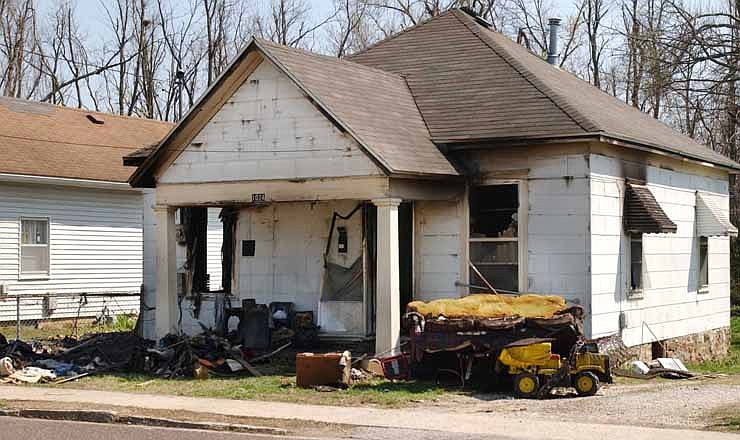SPRINGFIELD, Mo. (AP) - The crime was brutal: a 7-year-old girl choked, raped and forced to smoke drugs before she was left for dead in a fire set by her attacker. Somehow, she survived. Firefighters founder her at dawn, stumbling through the street and wearing just one shoe.
The child couldn't initially name her attacker, but police quickly targeted a 36-year-old with a lengthy rap sheet who had first met the girl hours earlier at an all-night card game hosted by his cousin. The girl's grandmother brought her there and left her to watch TV and play video games in a nearby bedroom.
A Greene County jury found Jeffery Allen Dickson guilty of child kidnapping, forcible rape and forcible sodomy in the April 6, 2008, attack, and a judge sentenced Dickson to four consecutive life terms. He remains imprisoned at the Potosi Correctional Center in southeast Missouri.
The case shocked and horrified local residents, and Dickson's arrest days later eased the minds of those who feared that a child rapist remained on the loose. But new evidence unearthed by Dickson's state-appointed appeals court lawyer and reviewed as part of a five-month Associated Press investigation suggests that a rush to judgment could have caused police and prosecutors to target the wrong man.
According to prosecutors, Dickson set the house at 1024 W. Nichols St. ablaze to cover up his crime - presumably leaving his young victim to die at a home he and his cousin visited earlier that night to buy a used television. But Springfield police and fire investigators appear to have overlooked, or downplayed, a second house that burned down one block away and on the same street, two months before the attack.
Tan carpet fibers found in the girl's hair resemble ones from the house at 1101 W. Nichols St., not the dark brown carpet in the house that caught fire two months later.
The distraught child's account of the attack and her testimony at trial 16 months later had significant contradictions: the girl described an infant's mobile in the bedroom where she was raped, and a hole in the floor of the house where she was lured with the promise of a Barbie doll. But the single mother who lived at 1024 W. Nichols said her toddler son's room didn't have such a toy. There was no hole in the floor before the fire. And the doctors and nurses who examined the girl found no evidence of smoke inhalation.
The Associated Press typically does not name victims of sexual assault.
The child repeatedly described the home where she was raped as "burnt" - which would also suggest the attack didn't take place where police said.
With no eyewitnesses and conflicting statements from the seven card players, prosecutors relied on DNA evidence to help convict Dickson. But Dickson's DNA sample, which showed a one-in-3,636 chance that he committed the crime, was tainted when the state crime lab improperly commingled the suspect's biological sample with that of the victim and two other men, records show. He was never charged with arson.
"The state argued that he left her in a burning house to show motive," said Valerie Leftwich, a state public defender handling Dickson's current appeal. "They knew my defendant had been at that location. They can't tie him to the other house."
Leftwich declined to make Dickson available for an interview. But in a series of brief telephone conversations from prison, Dickson repeatedly professed his innocence to The Associated Press.
In March 2011, the Missouri Court of Appeals upheld Dickson's August 2009 conviction, though the appeals court did not hear evidence about the second house fire or the DNA errors. Dickson, who is now 41, was scheduled to return to court for a two-day hearing starting Tuesday, but the hearing was postponed Friday.
Leftwich said prosecutors asked for more time to review testimony by an expert witness, Dean Stetler, a University of Kansas molecular biology professor.
Russ Dempsey, one of two assistant prosecutors at the first trial, said he remains convinced of Dickson's guilt.
"He was the one who went in and raped her. It's clear to me, it's a good conviction," Dempsey said.
Hours before the attack, the victim's grandmother was among a group of at least seven card players at the home of Dickson's cousin Gary McElroy. According to testimony at his trial, Dickson didn't play cards but instead came and went from the home several times.
Dickson's brother Terry said his sibling was a crack cocaine user who went to 1024 W. Nichols to help broker a TV-for-drugs trade with one of the other card players. The jury wouldn't hear that account - before trial, prosecutors successfully petitioned the court to bar any mention of "prior bad acts" by witnesses, including drug use.
McElroy, Stewart and three other card players testified that Jeffery Dickson had two brief encounters with the child earlier in the evening: he brought her a glass of Kool-Aid and helped fix the computer. Those interactions formed the basis for the accusations that would lead to Dickson's conviction.
Leftwich said the other card players "decided Jeff did this, so we are going to tell the police Jeff did it. They all just convinced each other, and decided in their minds."
Also unclear are the roles of several other card players who were not called to testify at trial and apparently not interviewed, or located, by police. That group includes two women and, according to both the child's grandmother and a card player who has since died, two other, unidentified men.
Genetic testing by the Missouri State Highway Patrol's crime lab focused on samples taken from the victim's thigh and abdomen. In most rapes, vaginal samples also are taken - but in this case the emergency room doctor opted against that step, worried about further traumatizing the child. That oversight ultimately led to a change in hospital policy.
Rather than a full DNA screening, known as an autosomal profile, the Highway Patrol lab was only able to develop a biological connection between Dickson and the child testing for male-specific Y chromosomes. And those tests only found a sample that could also match more than 3,600 other men - including those in Dickson's paternal lineage, such as his brother Terry. The younger Dickson denied any involvement in the attack.
In October 2011, state crime lab analyst Malena Jimenez acknowledged that she simultaneously tested genetic samples from the victim's thigh and the suspect's penis - a breach of accepted protocol that could cause cross-contamination. The two samples, though contained in individual test tubes, were placed in adjoining slots in a container that held 96 unrelated samples, some of which were also processed at the same time.
The lab tests also found DNA from two other people mixed with Dickson's sample, which his attorney said "could also be due to cross-contamination, or it could be the DNA from the actual perpetrator of the case." DNA not belonging to Dickson was also found under the girl's fingernails.


